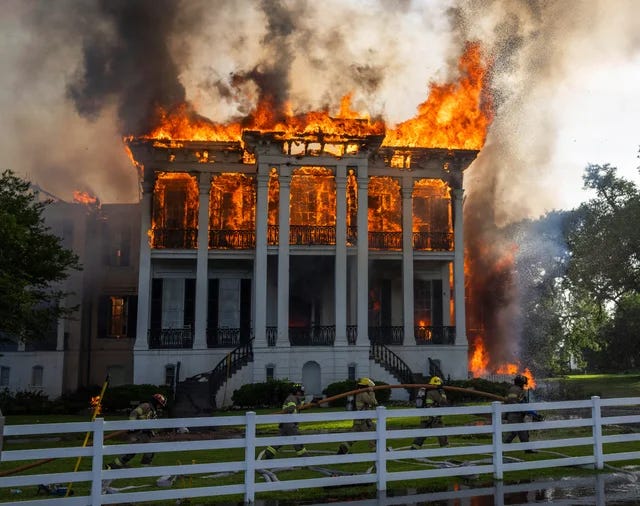
It’s not yet clear what caused the Nottoway plantation in Louisiana to burn beyond salvaging on May 15th, but if you ask Online Black America, there’s a solid chance The Ancestors were involved. From The Guardian:
Flames ripped through a massive mansion in Louisiana, destroying much of the historic structure that was used as a plantation house when it was completed in 1859 before eventually becoming “a place of reflection, education and dialogue” given the more than 150 people who were enslaved there before the abolition of slavery in the US, authorities said.
The fire that engulfed the Nottoway plantation house on Thursday devastated the building along the Mississippi River between Baton Rouge and New Orleans, Chris Daigle, the president of Iberville parish (Louisiana’s term for county), said on social media. Nearly a dozen fire departments from surrounding towns battled the blaze, he said. No injuries were reported.
Before the fire, the mansion was a resort and event venue, and its website described it as “the south’s largest remaining antebellum mansion”. Daigle called it “a cornerstone of our tourism economy and a site of national significance”.
In a statement on Facebook, Daigle also made it a point to touch on the structure’s history of racial injustice during a time when enslaved Black people helped build the site and operate the sugar plantation that surrounded it. In 1860, 155 enslaved people were held at the property, according to National Park Service records.
“While its early history is undeniably tied to a time of great injustice, over the last several decades it evolved into a place of reflection, education, and dialogue,” Daigle said.
“Since the 1980s, it has welcomed visitors from around the world who came to appreciate its architecture and confront the legacies of its era,” he added. “It stood as both a cautionary monument and a testament to the importance of preserving history – even the painful parts – so that future generations can learn and grow from it.”
The 53,000-sq-ft (4,900-sq-meter) home on a former sugar plantation about 65 miles (105km) north-west of New Orleans had a three-story rotunda adorned with giant white columns and hand-carved Italian marble fireplaces, according to a description on its website.
The mansion’s owner, Louisiana attorney Dan Dyess, said in a written statement that the fire had led to a “total loss” after all the time and money he invested in the building.
“We are devastated and heartbroken for this loss,” he said. “This was my dream that has now been dashed.”
The cause of the fire remains unknown, but the celebratory reactions on social media were impossible to miss.
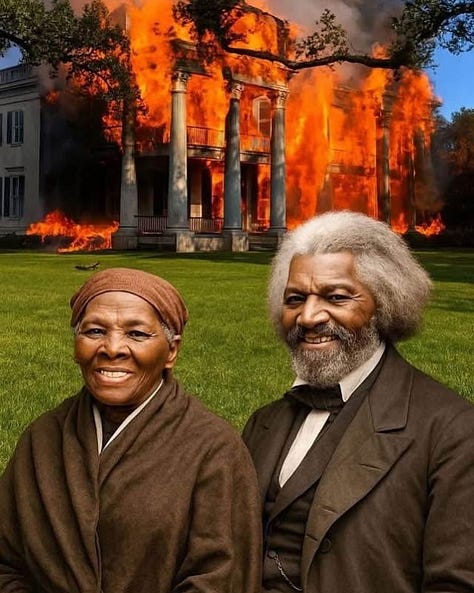
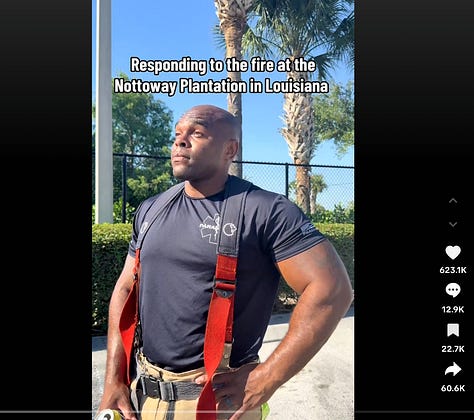
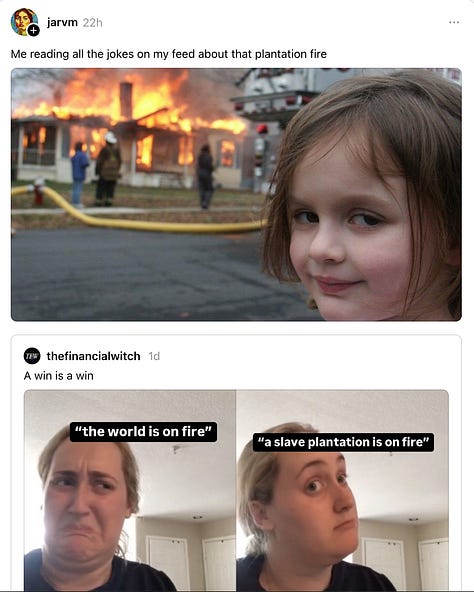

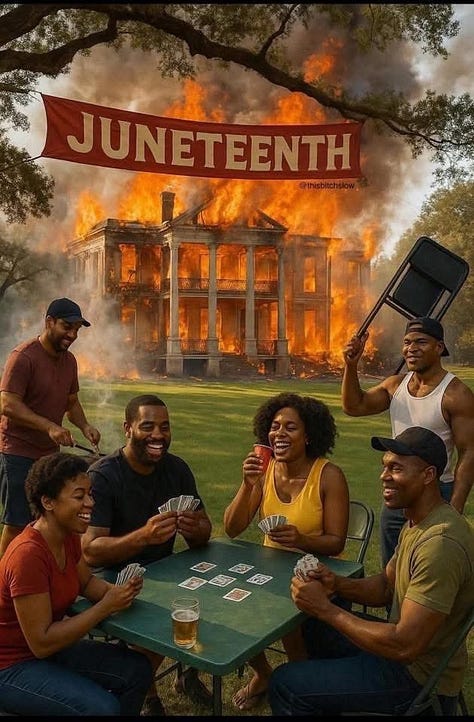
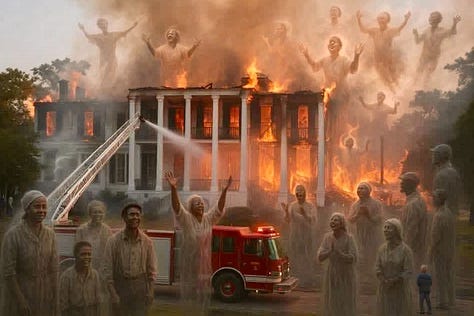
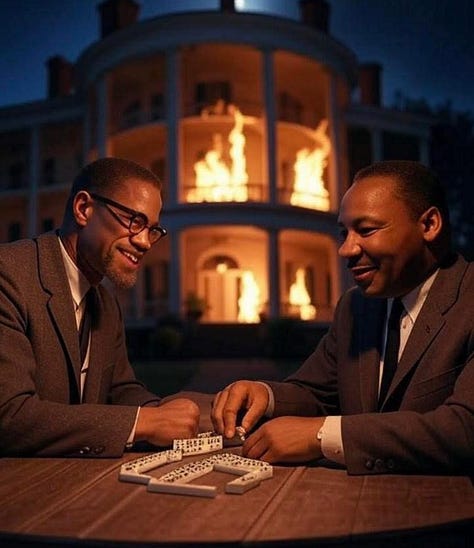

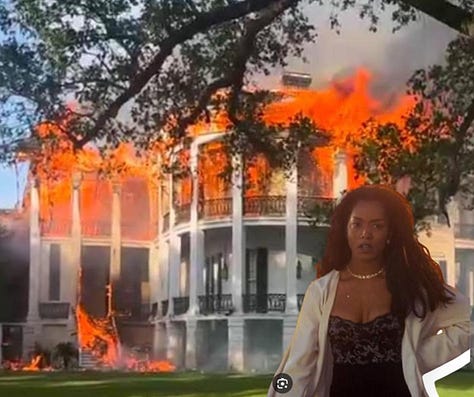
Unsurprisingly, the comments on the many TikTok posts about the conflagration were savage:
… including several expressions of love and sympathy for the fire:
There were even claims floating around online, that the fire was caused by a tour of the cursed Annabelle doll stopping in New Orleans the day before, and creators who swore they spotted actual spirits in the Nottoway flames, which they took to be ancestral enslaved people finally being liberated from the very haunted mansion. There was also this Reddit bigup to Union General William Tecumseh Sherman’s ghost for “winning” the conflagration (again).
For those who are offended by the mainly Black … but far from solely Black, online joy, consider the variation in the ways that many white and Black Americans process the meaning of places like Nottoway plantation, which for many African-Americans are tombs for the unrested souls of our ancestors, while for many white Americans they are merely lovely places to hold a glamorous wedding. And this broad inability for so many Americans, to really confront or accept the horrors of slavery continues to divide so much of this country.
To be clear, and in case you’re ever asked, we don’t even need family oral histories to be able to tell you that just about every enslaved person at the time that awful institution existed in this country, dreamed at least on occasion, of setting fire to the “big house” with the entire captor family in it. Not a single enslaved person enjoyed or benefited from slavery, nor were they “grateful” for it, and every one of them would have run away if they could have. There were continual slave uprisings, and constant flight from plantations from 1619 til the civil war because Black people and their white allies, hated slavery, no matter what a friendly tour guide at an “Antebellum wedding mansion” tells you. And then there’s this point, by Kevin M. Levin, from his Civil War Memory Substack:
A number of news reports about the fire include a quote from the mayor of Iberville Parish, who made it a point to note that the site was a destination to learn about the complicated history of slavery.
I applaud any attempt to address this history. Plantations like Nottoway, was as much the home of the hundreds of African Americans enslaved there as it was their white enslavers. It was literally part of the ‘world that the slaves made’ and we honor their memory when we acknowledge this fact and learn more about their lives on site.
Here is the full statement from the mayor.
But after discovering the website for the home, I couldn’t find a single reference to the history of enslavement at Nottoway. Click on the “history” tab in the top navigation menu and the only subject referenced is the plantation’s impressive oak trees. The page devoted tours offers no information other than time and a recommendation that visitors should call ahead for confirmation.
Indeed, I checked, and the only thing listed on the History page on the site is a very detailed accounting of those trees — their diameters and even their ages, and their connection to the plantation owner’s children. The humans enslaved on that plantation, and who literally built it, do not exist in that online history, as if Trump’s history-erasing executive order had been thoroughly applied. There’s also a Portraits page, advertising how ladies can dress themselves up to look like a plantation mistress and be photographed, unironically, for posterity. On the page are mainly white women, plus one very ironic Black bride.
The same callousness toward the pain the existence of this antebellum relic represented to so many in Louisiana and elsewhere, and to the humanity of the captives forced to work there is evidenced in this 1936 abstract from a thesis biography of John Hamden Randolph:
John Hampden Randolph, a native of Virginia born in 1813 came to Mississippi with his parents in 1819. He grew up on his father's plantation in Wilkinson County and subsequently became a cotton farmer. This was his occupation in Mississippi until 1841 when he bought a plantation in Iberville Parish, Louisiana to which he moved in December of that year. For three years he raised cotton as a staple on his plantation. "Forest Rome," but at the end of that time changed to sugar cane.
In the period prior to the Civil War and in the years shortly after its close, Randolph built up a large estate and in the meantime became a very successful sugar planter. By 1871 his landed possessions in Iberville Parish amounted to over 7000 acres which, however, included more than 3000 acres of swamp land. He also owned lands in the states of Iowa, Minnesota, and Texas. In 1858 he built a beautiful mansion on his plantation fronting the Mississippi River and named it "Nottoway," after the County in Virginia where his ancestors had lived.
During the Civil War Randolph held on to his land in Louisiana and Texas, and about 1863 took his slaves and other valuable property to Texas, where he cultivated his land in that state. After the war he returned to Louisiana with a number of the Negroes, many of whom continued to work for him as freedmen.
The estate diminished in size in the 1870's and at the time of his death in 1883, Randolph owned only Nottoway plantation end his swamp land. His heirs disposed of these lands that remained.
“…slaves and other valuable property…”
And Randolph was an aggressive “property” acquirer:
Randolph, a planter from wealthy, prominent Virginia family, moved down to the Deep South to try his hand at growing sugar cane, according Sarah Duggan, project manager for Decorative Arts of the Gulf South at The Historic New Orleans Collection.
Once here, he commissioned renowned architect Henry Howard of New Orleans — a prolific designer behind some of Louisiana's most iconic buildings, including the Pontalba buildings in Jackson Square and the Robert Short house — to draw up the grandiose Greek Revival and Italianate style mansion.
Under Howard's guidances, slaves built the house mostly from cypress trees in the nearby swamplands along the neighboring Mississippi River.
The extravagant home was fitted with many of the highest luxuries of the time: flushing toilets and hot and cold water in all bathrooms (thanks to 10,000 gallon copper tank), gas lighting, a grand 65-foot ballroom and a bowling alley installed for Randolph’s 11 children.
By 1860, Randolph owned 155 enslaved Black people and 6,200 acres on the Nottoway plantation, 1,200 of which were under cultivation, according to a 1980 National Register of Historic Places nomination form submitted for the property.
Compared to other Louisiana plantations, Nottoway stands out to Duggan because of its enormous scale and the fact that it was built much later on than others.
The complex, like nearby counterparts, would have included slave quarters, lined up in a straight row beyond the main house, but close enough to be surveilled by Randolph or another overseer, Duggan said.
During the Civil War, the compound managed to avoid sustaining any major damage, like many of Louisiana's other large plantations. And even after enslaved people in the U.S. were emancipated, life at Nottoway would likely have continued similarly, as many of the now freed slaves found themselves forced into the sharecropping system.
"That is absolutely a big part of the story," Duggan said.
"If you think about it, if that's only place you've lived your whole life, your family is there — your friends, your family, your community. And if you were enslaved, you were kept illiterate, so it would be so difficult to leave."
From Owens family to tourist destination
By 1912, the grand mansion was acquired by the Owens family and passed on through their generations until 1977. That year, Odessa Rushing Owens, a retired schoolteacher, sold the 32-acre property to construction company owner Arlin K. Dease for $720,000 — under the stipulation that she could continue living in the house.
Dease, who was described in a 1980 Times-Picayune article as a lover of antiques and history, set out to revive the home using knowledge he'd gained from renovating other historic homes in Louisiana, including The Myrtles in St. Francisville.
After the renovations were complete, Dease opened the home for tours and wedding receptions. Over the years he expanded the property, adding a 300-seat restaurant for receptions and opening 10 bedrooms to overnight guests.
Five years later, Dease sold the property for $4.5 million to Australian Paul J. Ramsey and Boston native Peter J. Evans, owners of the Ramsey Hospital Corporation that operated River West Medical Center, a former hospital in Plaquemine.
Nottoway's attractions grew as Ramsey added more spaces for guests and several meeting rooms. It was under his ownership that the historic home came to be known as a resort destination.
Reckoning with the past
Nottoway has since changed hands a couple of times over the past few years, first being purchased by the late hotelier Joe Jaeger Jr. in 2019 and then by Dan Dyess, a Natchitoches area lawyer, in late 2024. Dyess also owns the historic Steel Magnolia House Bed and Breakfast in Natchitoches.
Despite the home's past ties to slavery, the latest version of Nottoway Resort's website avoids any mention of slaves or slave labor.
Which is why so many this weekend are saying, “burn baby, burn…”
Devastation in the Midwest
There have been devastating tornadoes in Illinois, Missouri and Kentucky, including a massive wall of dust sweeping across Chicago. Unlike previous storms, the damage from these storms is focused on the urban areas in places like Chicago and North and West St. Louis.
If you are able and willing to donate to help those in need, you can click here for the ActBlue donation site.






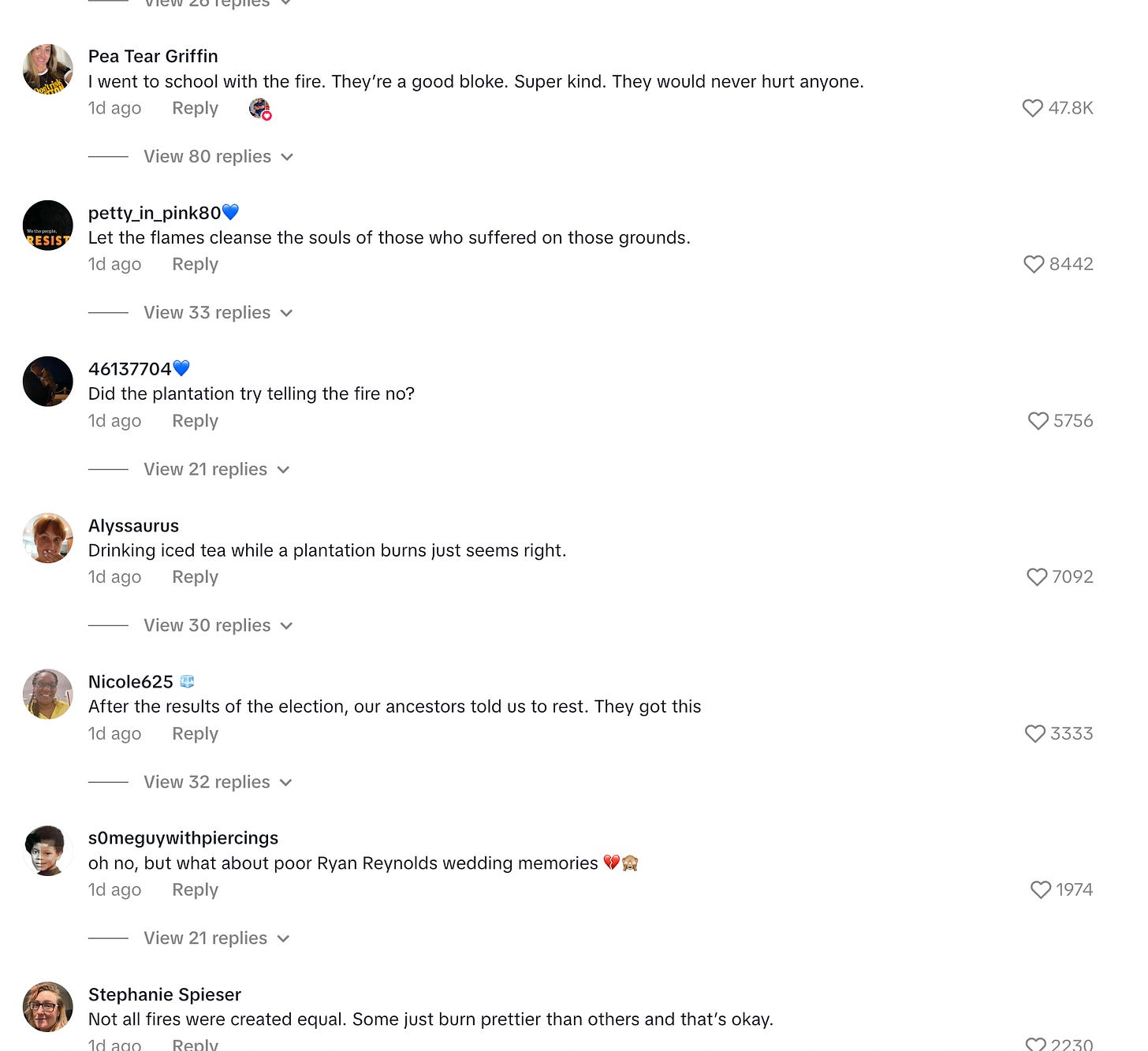
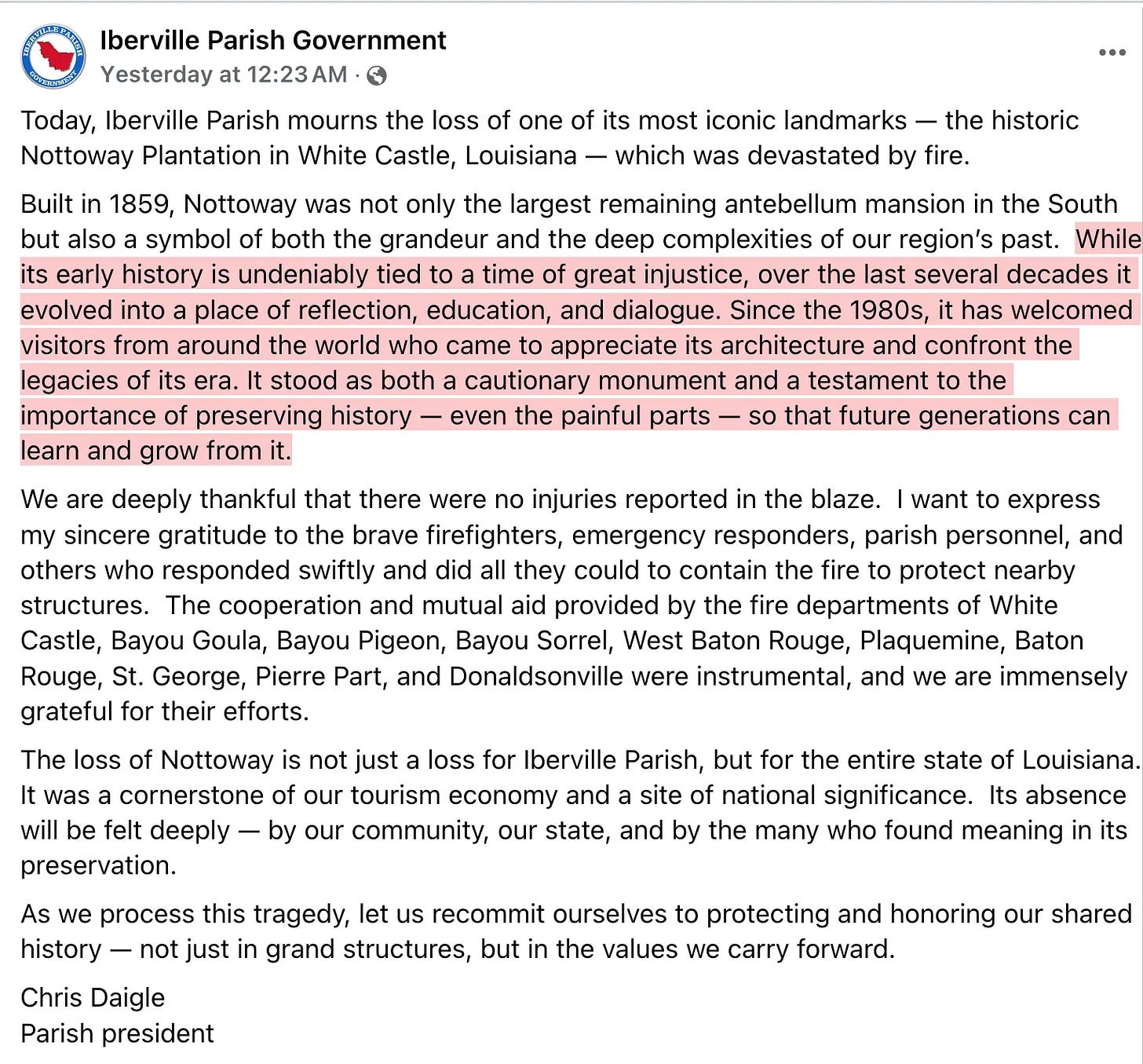
Considering they are hiding what really went down around that plantation, I'm glad it burned too. Thanks for the history lesson.
On another note, you may think you're saving yourself from managing trolls on Substack, by putting everything behind a paywall, but it's going to bite you in the butt, Mrs. Reid. There's enough of us around that we'll shout down your aggressors, but if you really want a lot of people subscribing to you, you'll take that off. If you want to paywall anything, do it to your chat. Otherwise, you're insulting everybody's intelligence by disallowing comments in your articles except to those who pay. I won't do it for long myself.
As the son of a Black celebrity & elder, you should know 1) There aren't a bunch of Black people on this platform. 2) Celebrities are a dime a dozen around here. 3) We value those who value us as readers.
You don't have to listen to me, but after observing this place for a little over a year, I think I might be on the mark. I too established an account years ago, and came back here to write after I got chased off Medium for beaning white men in the head for trolling Black women's articles there. Peace!
On a more "Joy"ous note, thanks for this article and the funny memes and thanks for all that you do. Let's thank the ancestors for taking down this monument to slavery. May it's ashes give those who lived and work there a bit of peace.